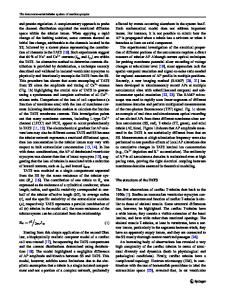Review of the crushing response of collapsible tubular structures
- PDF / 6,892,584 Bytes
- 37 Pages / 595.276 x 785.197 pts Page_size
- 68 Downloads / 326 Views
REVIEW ARTICLE
Vivek PATEL, Gaurav TIWARI, Ravikumar DUMPALA
Review of the crushing response of collapsible tubular structures
© Higher Education Press and Springer-Verlag GmbH Germany, part of Springer Nature 2020
Abstract Studies on determining and analyzing the crushing response of tubular structures are of significant interest, primarily due to their relation to safety. Several aspects of tubular structures, such as geometry, material, configuration, and hybrid structure, have been used as criteria for evaluation. In this review, a comprehensive analysis of the important findings of extensive research on understanding the crushing response of thin-walled tubular structures is presented. Advancements in thin-walled structures, including multi-cell tube, honeycomb and foam-filled, multi wall, and functionally graded thickness tubes, are also discussed, focusing on their energy absorption ability. An extensive review of experimentation and numerical analysis used to extract the deformation behavior of materials, such as aluminum and steel, against static and dynamic loadings are also provided. Several tube shapes, such as tubes of uniform and nonuniform (tapered) cross sections of circular, square, and rectangular shapes, have been used in different studies to identify their efficacy. Apart from geometric and loading parameters, the effects of fabrication process, heat treatment, and triggering mechanism on initiating plastic deformation, such as cutouts and grooves, on the surface of tubular structures are discussed. Keywords monolithic structure, crashworthiness, energy absorber, static and dynamic loadings, multicellular tube structure, filled tube
1
Introduction
With the advancement of combustion engines, the use of Received May 31, 2019; accepted November 23, 2019
✉
Vivek PATEL ( ), Gaurav TIWARI, Ravikumar DUMPALA Department of Mechanical Engineering, Visvesvaraya National Institute of Technology, Nagpur 440010, India E-mail: [email protected]
high-speed vehicles in daily life is increasing day by day. Safety requirements should be enhanced to mitigate probable accidental damages. The occurrence of impact or collision involving automobiles is a common phenomenon associated with their use. In this context, engineers and researchers are continuously attempting to develop structures that can absorb most of the energy transferred to a vehicle during collision, such that minimum or no damage can occur to the passengers. The capability of a structure to absorb impact energy in a stable manner and provide safety to its occupants is known as crashworthiness. The geometry and material of a structure are important aspects to consider when developing an efficient energy-absorbing component. Numerous studies have been conducted on different structures, such as monolithic tubes with different cross sections, multi-tubular and corrugated tubes, sandwich structures with a honeycomb or foam core, and multi cell tubes. The performance of structures against crushing loads (longitudinal, oblique, and eccentric loadin
Data Loading...











